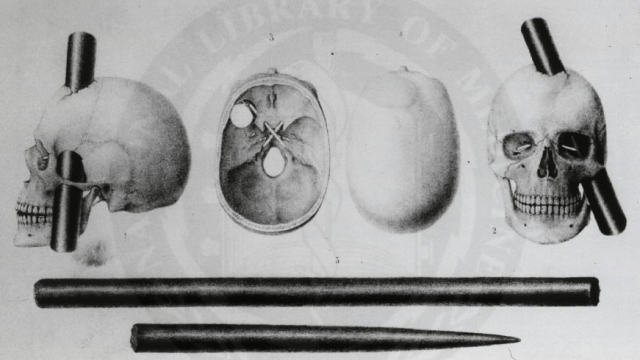On September 13, 1848, an accidental explosion drove a metre-long iron rod through the skull of Vermont railway worker Phineas Gage. Incredibly, Gage survived, but the lingering side effects provided science its first clues about how the brain affects our personality.
The rod was driven straight up through the skull, passing just under the left eye and into his brain. The rod kept right on going, landing about 30m from the injured Gage. Remarkably, Gage was brought back to health by local physician John Harlow, and he even lived for another 12 years. But Gage was never quite the same, becoming unreliable, profane and given to inappropriate remarks, as though he had lost all his inhibitions.
Cardiff University neuroscientist John Aggleton explains:
“It’s reported that he became what now would be classically described as ‘disinhibited’ – this is a classic term for what happens to some people after damage to their frontal lobes. So, he loses his inhibitions, both in a social and emotional context. He would be rather high. Difficult company, to put it mildly.”
To be fair, if I had a metre-long iron rod driven through my skull, I feel like I might just stop caring about punctuality or social niceties, even if my brain was completely undamaged. Of course, that was just a small fraction of Gage’s personality change, as Dr Harlow reported:
Gage was fitful, irreverent, indulging at times in the grossest profanity (which was not previously his custom), manifesting but little deference for his fellows, impatient of restraint or advice when it conflicts with his desires, at times pertinaciously obstinate, yet capricious and vacillating, devising many plans of future operations, which are no sooner arranged than they are abandoned in turn for others appearing more feasible. A child in his intellectual capacity and manifestations, he has the animal passions of a strong man. Previous to his injury, although untrained in the schools, he possessed a well-balanced mind, and was looked upon by those who knew him as a shrewd, smart businessman, very energetic and persistent in executing all his plans of operation. In this regard his mind was radically changed, so decidedly that his friends and acquaintances said he was ‘no longer Gage.’
It wasn’t just his personality that was affected. He only remembered about half the friends he had had before the accident, and he lost any concept of money. Dr Harlow once offered Gage $US1000 for a few pebbles he had on him, but Gage refused, as though he had no way of judging the value of the money relative to his pebbles.
Gage’s injury revealed something fundamental about the brain, as Melbourne University psychologist and Gage expert Malcolm Macmillan explains:
“When Phineas’ accident occurred, there was no accepted doctrine of the brain having functions. The only point of view that was opposed to that was that of the phrenologists, the people who thought that bumps on the outside of the skull indicated the organs within the brain – therefore the parts of the brain that had particular functions.”
Experts had various different takes on Gage’s injury. Some argued his personality change revealed certain parts of the brain were responsible for specific functions, and their destruction had robbed Gage of a part of his personality. Others argued the fact that Gage still functioned at all was proof that the brain could rearrange its structure and assign different parts of the brain to take over the tasks of the destroyed areas. The truth lies somewhere in the middle.
Gage lived for another 12 years after his accident, but his story doesn’t have a happy ending. In 1859, he moved to San Francisco to live with his family, as his increasingly poor health and epileptic fits made him unable to support himself. He died in 1860, and MacMillan suspects the iron rod ultimately finished off the job it began back in 1848:
“Some of the late-term effects of that sort of traumatic brain injury is the formation of scar tissue. Scar tissue frequently becomes the point from which epilepsy develops.”
He is said to have been buried with the iron rod, but his rest didn’t last long. In 1867, Dr Harlow secured permission to exhume the body, and Gage’s skull now sits on display next to the rod at the Harvard Medical School.
For more on this story, check out BBC News. Image via ScienceBlogs.
Republished from io9
